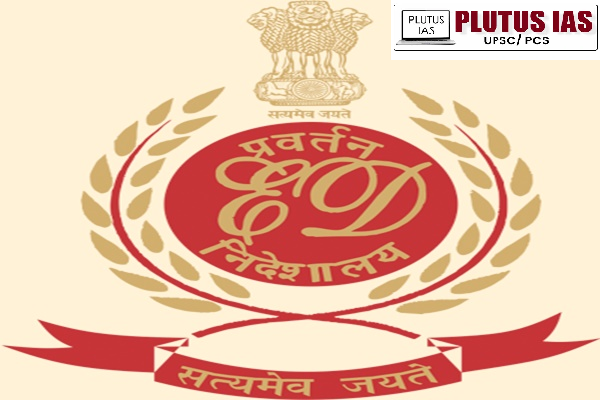19 Jun Combating Money Laundering: Legal Provisions and Institutional Mechanisms
This article covers “Daily Current Affairs” and the Topic of Combating Money Laundering: Legal Provisions and Institutional Mechanisms
SYLLABUS MAPPING:
GS-3- Internal Security- Combating Money Laundering: Legal Provisions and Institutional Mechanisms
FOR PRELIMS
What is money laundering? What are the major challenges faced by India in tackling money laundering?
FOR MAINS
What role does international cooperation and agreements (like FATF, UN Conventions) play in combating money laundering?
Why in the News?
Enforcement Directorate is conducting searches at 37 premises of contractors and private entities involved in the Delhi classroom construction scam. The case is related to an FIR registered by Anti Anti-Corruption Branch of Delhi Police against the then City Ministers and Aam Aadmi Party leaders Manish Sisodia and Satyendra Jain, and other private persons for alleged irregularities in the construction of additional classrooms in various schools in the national capital.

Institutional Framework to Prevent Money Laundering in India
| Institution | Role/Function |
|---|---|
| Financial Intelligence Unit – India (FIU-IND) | Collects, analyses, and disseminates financial intelligence related to suspicious transactions. |
| Enforcement Directorate (ED) | Investigates and prosecutes money laundering under PMLA. |
| Reserve Bank of India (RBI) | Issues KYC/AML guidelines to banks and monitors compliance. |
| Securities and Exchange Board of India (SEBI) | Regulates capital markets and ensures AML compliance by market intermediaries. |
| Directorate of Revenue Intelligence (DRI) | Investigates smuggling and trade-based money laundering. |
| Central Board of Direct Taxes (CBDT) | Tracks tax evasion and illegal financial flows. |
| Central Economic Intelligence Bureau (CEIB) | Coordinate intelligence sharing among agencies. |
Legal Framework for Anti-Money Laundering
| Legislation | Key Provisions |
|---|---|
| Prevention of Money Laundering Act (PMLA), 2002 | Defines and criminalizes money laundering; provides for attachment, adjudication, and confiscation of property. |
| Benami Transactions (Prohibition) Act, 1988 (Amended 2016) | Prohibits holding property in benami names to curb black money. |
| Fugitive Economic Offenders Act, 2018 | Allows confiscation of properties of economic offenders who flee the country. |
| Foreign Exchange Management Act (FEMA), 1999 | Regulates cross-border financial transactions. |
| Companies Act, 2013 | Imposes compliance obligations to prevent shell companies and round-tripping. |
Analysis of the Framework
1. Alignment with Global Standards: India has significantly strengthened its AML framework to comply with the Financial Action Task Force (FATF) recommendations, including the criminalization of money laundering and robust reporting obligations.
2. FIU-IND’s Increasing Role: The growing number of Suspicious Transaction Reports (STRs) filed by financial institutions reflects heightened awareness, surveillance, and data analytics by the Financial Intelligence Unit.
3. PMLA as a Deterrent: The Prevention of Money Laundering Act (PMLA), 2002, empowers authorities to attach, confiscate, and prosecute money laundering offences, acting as a powerful tool against economic offenders.
4. Judicial Endorsement with Nuances: The Supreme Court has upheld the constitutional validity of PMLA but also highlighted the need for due process and safeguards against arbitrary application.
5. Multi-agency Involvement: Agencies like ED, SEBI, RBI, and CBDT play complementary roles, ensuring comprehensive coverage across sectors, from banking and securities to taxation.
6. Gaps in Conviction and Trial: Despite many investigations and property seizures, actual conviction rates under PMLA remain low, reflecting prosecution challenges and procedural delays.
7. Overlaps and Jurisdictional Confusion: Multiple institutions sometimes lead to coordination issues, duplication of efforts, and delays in decisive enforcement actions.
8. Slow Legal Processes: Special PMLA courts face a backlog of cases, undermining the swift delivery of justice and weakening the law’s deterrent value.
Key Challenges
| Challenge | Explanation |
|---|---|
| Over-criminalisation under PMLA | Issues of procedural fairness and overreach, especially concerning bail and attachment processes. |
| Low Conviction Rate | Despite many investigations, convictions under PMLA remain low, indicating gaps in prosecution and evidence. |
| Lack of Coordination | Duplication and weak inter-agency data sharing hamper efficiency. |
| Complex International Networks | Hawala, trade-based laundering, and digital assets complicate traceability. |
| Regulatory Arbitrage | Inconsistent enforcement across sectors creates loopholes. |
| Judicial Scrutiny | The Supreme Court and High Courts have questioned aspects of PMLA regarding individual rights and procedural safeguards. |
Way Forward
1. Streamline PMLA Provisions: Make the law more balanced by ensuring procedural fairness and speeding up trials.
2. Enhance Inter-agency Coordination: Create a unified digital intelligence-sharing platform among ED, FIU-IND, CBDT, and DRI.
3. Capacity Building: Train officials in forensic accounting, digital surveillance, and international compliance standards.
4. Strengthen Judicial Oversight: Fast-track special PMLA courts with adequate resources and judicial training.
5. Public-Private Cooperation: Encourage banks, fintechs, and corporates to report and flag suspicious activities proactively.
6. Global Cooperation: Deepen ties with FATF and Egmont Group to improve cross-border tracking and recovery of illicit assets.
7. Digital Regulation: Tighten KYC/AML norms for cryptocurrencies and digital financial services.
Conclusion
India’s legal and institutional framework to combat money laundering has evolved significantly, yet gaps remain in enforcement, judicial balance, and coordination. As financial crimes grow more complex with globalization and digitalization, a dynamic, accountable, and rights-respecting anti-money laundering regime is essential. A combination of legal reform, institutional strengthening, and global cooperation can ensure that financial integrity and justice go hand in hand.
Prelims Questions
Q. Which of the following is the nodal agency in India responsible for receiving and analyzing financial information related to suspected money laundering?
(a) Enforcement Directorate
(b) Financial Intelligence Unit – India (FIU-IND)
(c) Central Bureau of Investigation
(d) Reserve Bank of India
Answer: B
Mains Questions
Q. Discuss the institutional and legal framework established in India to combat money laundering. Critically analyze its effectiveness, highlight the key challenges, and suggest a way forward for ensuring a robust anti-money laundering regime.
(250 words, 15 marks)




No Comments